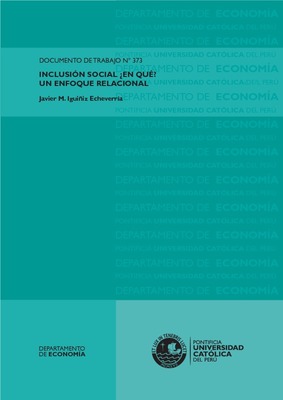| dc.contributor.author | Iguíñiz Echeverría, Javier | |
| dc.date.accessioned | 2015-03-19T20:37:56Z | |
| dc.date.available | 2015-03-19T20:37:56Z | |
| dc.date.issued | 2014 | |
| dc.identifier.uri | http://repositorio.pucp.edu.pe/index/handle/123456789/47014 | |
| dc.description.abstract | El objetivo general es mostrar la necesidad de una mirada multidimensional de la realidad. Para ello, cuatro conjuntos de gráficos nos permiten contrastar y complementar algunos de los elementos clásicos en el diagnóstico sobre América Latina durante las últimas décadas. El primero, sobre la brecha con los países ricos, muestra la evolución de largo plazo del PIB per capita y de indicadores básicos de salud y educación, para poner en evidencia que mientras en el primer caso se amplía en los otros dos se reduce. En el segundo conjunto mostramos que la “década perdida” en los ochenta del siglo pasado no fue una pérdida total. Algunos indicadores valiosos continuaron mostrando mejoras a pesar de la crisis. El tercero, muestra la diferencia entre la desigualdad regional al interior de varios países cuando se registra en términos económicos y en desarrollo humano. Finalmente, ploteamos en un plano indicadores económicos y de desarrollo humano de los países del mundo para ubicar a los países latinoamericanos y mostrar que estamos en una “esquina” en la que la reducción de privaciones básicas tiende a hacerse más lento y más caro. | es_ES |
| dc.description.abstract | Four sets of graphs allow us to contrast, and complement, some of the classic elements of the diagnosis that has dominated Latin American academic and political world during the last several decades. The first set shows the long term evolution of economic and human development indicators that are particularly sensitive to situations of extreme poverty, illiteracy and life expectancy, to indicate us that we should view Latin American development as a process of, simultaneously, widening and narrowing gaps. The second allow us to see that the “lost decade” was not a total loss. In spite of the generalized economic crisis, and the enormous, and terrible rise in economic poverty, some very elementary, but valuable, indicators of human progress continued improving. The third set of graphs presents the difference between the income levels of regions in selected countries, and the difference between the levels in the Human Development Index. Interregional economic disparities tend to be wider than human ones. Finally, we plot economic and basic human development indicators of the countries in the world to show that the Latin American countries are moving around a “corner” where the advance to solve some basic pivations is already great, but further advances in life expectancy will be small, and more and more expensive. | en_US |
| dc.language.iso | spa | es_ES |
| dc.publisher | Pontificia Universidad Católica del Perú. Departamento de Economía | es_ES |
| dc.relation.ispartof | urn:issn:2079-8466 | |
| dc.relation.ispartof | urn:issn:2079-8474 | |
| dc.relation.ispartofseries | Documento de Trabajo;373 | es_ES |
| dc.rights | info:eu-repo/semantics/openAccess | es_ES |
| dc.rights.uri | http://creativecommons.org/licenses/by-nc-nd/2.5/pe/ | * |
| dc.subject | Inclusión social--América Latina | es_ES |
| dc.subject | Desarrollo humano--América Latina | es_ES |
| dc.subject | Desarrollo económico--América Latina | es_ES |
| dc.title | Inclusión social ¿En qué? Un enfoque relacional | es_ES |
| dc.title.alternative | Social inclusion into what? A relational approach. | en_US |
| dc.type | info:eu-repo/semantics/workingPaper | |
| dc.type.other | Documento de trabajo | |
| dc.subject.ocde | http://purl.org/pe-repo/ocde/ford#5.02.00 | |
| dc.publisher.country | PE | |
| renati.advisor.orcid | https://orcid.org/0000-0003-3910-0677 | |


